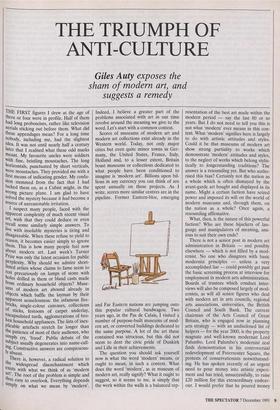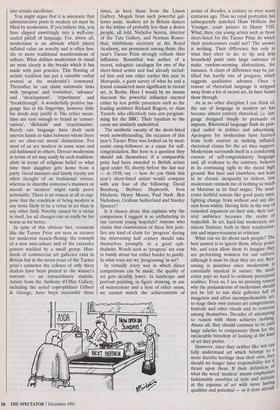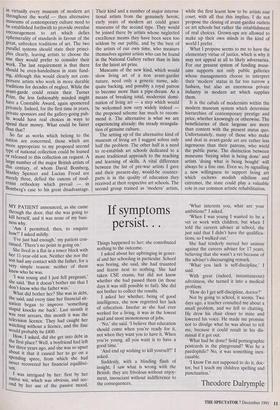THE TRIUMPH OF ANTI-CULTURE
Giles Auty exposes the
sham of modern art, and suggests a remedy
THE FIRST figures I drew at the age of three or four were in profile. Half of them had long proboscises, rather like television aerials sticking out before them. What did these appendages mean? For a long time nobody, including me, had the slightest idea. It was not until nearly half a century later that I realised what these odd marks meant. My favourite uncles were soldiers with fine, bristling moustaches. The long horizontals, punctuated by short verticals, were moustaches. They provided me with a first means of indicating gender. My confu- sion stemmed from the fact that I had tacked them on, as a Cubist might, in the Wrong picture plane. I am glad to have solved the mystery because it had become a source of unreasonable irritation.
I suspect many people, faced with the apparent complexity of much recent visual art, wish that they could deduce or even recall some similarly simple answers. To live with insoluble mysteries is tiring and disagreeable. When these refuse to yield to reason, it becomes easier simply to ignore them. This is how many people feel now about modern art. Last week's Turner Prize was only the latest occasion for public Perplexity. Why should we admire short- listed artists whose claims to fame seem to rest precariously on lumps of stone with holes drilled in them or bland casts made from ordinary household objects? Muse- ums of modern art abound already in objects which baffle the layman by their apparent senselessness: the infamous fire- bricks, single-colour canvases, collections of sticks, festoons of carpet underlay, ,encapsulated turds, agglomerations of bro- ken household appliances. The lists of inex- plicable artefacts stretch far longer than the patience of most of their audience, who simply cry, 'fraud'. Public debate of the subject usually degenerates into name-call- !rig. Constructive answers are conspicuous- 13r absent.
There is, however, a radical solution to the widespread disenchantment which exists with what we think of as 'modern an% The root of the problem is simple and thus easy to overlook. Everything depends simply on what we mean by 'modern'.
Indeed, I believe a greater part of the problems associated with art in our time revolve around the meaning we give to the word. Let's start with a common context.
Scores of museums of modern art and modern art collections exist already in the Western world. Today, not only major cities but even quite minor towns in Ger- many, the United States, France, Italy, Holland and, to a lesser extent, Britain boast museums or collections dedicated to what people have been conditioned to imagine is 'modern art'. Billions upon bil- lions in any currency you can think of are spent annually on these projects. As I write, scores more similar centres are in the pipeline. Former Eastern-bloc, emerging and Far Eastern nations are jumping onto this popular cultural bandwagon. Two years ago, in the Pas de Calais, I visited a number of purpose-built museums of mod- ern art, or converted buildings dedicated to the same purpose. A lot of the art these contained was atrocious, but this did not seem to dent the civic pride of Dunkirk and Lille in their achievements.
The question you should ask yourself now is what the word 'modern' means, or ought to mean, in such a context. What does the word 'modern', as in museum of modern art, really signify? What it ought to suggest, so it seems to me, is simply that the work within the walls is a balanced rep-
resentation of the best art made within the modern period — say the last 80 or so years. But I do not need to tell you this is not what 'modern' ever means in this con- text. What 'modern' signifies here is largely to do with artistic attitudes and styles. Could it be that museums of modern art show strong partiality to works which demonstrate 'modern' attitudes and styles, to the neglect of works which belong stylis- tically to longerstanding traditions? The answer is a resounding yes. But who autho- rised this bias? Certainly not the nation as a whole which is often dismayed by the avant-garde art bought and displayed in its name. Might a certain faction have seized power and imposed its will on the world of modern museums and, through them, on the nation as a whole? Once again, a resounding affirmative.
What, then, is the nature of this powerful faction? Who are these hijackers of lan- guage and manipulators of meaning, anx- ious to suit their own ends?
There is not a senior post in modern art administration in Britain — and possibly elsewhere — which is not filled by a mod- ernist. No one who disagrees with basic modernist principles — unless a very accomplished liar — could possibly get past the basic screening process at interview for employment in modern arts administration. Boards of trustees which conduct inter- views will also be composed largely of mod- ernists, as will all senior figures who deal with modern art in arts councils, regional arts associations, universities, the British Council and South Bank. The current chairman of the Arts Council of Great Britain, who is engaged now in planning arts strategy — with an undisclosed list of helpers — for the year 2000, is the property magnate and well-known modernist Lord Palumbo. Lord Palumbo's modernist zeal finds demonstration in his controversial redevelopment of Paternoster Square, the protests of conservationists notwithstand- ing. He has spoken recently of an urgent need to pour money into artistic ,experi- ment and has tried, unsuccessfully, to raise £20 million for this extraordinary endeav- our. I would prefer that he poured money into artistic excellence.
You might argue that it is axiomatic that administrative posts in modern art must be filled by modernists. If you believe this, you have slipped unwittingly into a well-con- cealed pitfall of language. For, above all, modernism is an attitude which places inflated value on novelty and is often hos- tile to more traditional manifestations of culture. What defines modernism in visual art most clearly is the breaks which it has made with past practice. This flouting of artistic tradition has put a valuable verbal arsenal at the modernist's command. Thereafter he can claim automatic links with 'progress' and 'evolution', 'advance' and 'development', 'experiment' and `breakthrough'. A wonderfully positive lan- guage lies at his fingertips, however little his deeds may justify it. His critics mean- time are easy enough to brand as 'conser- vatives', 'diehards' and 'reactionaries'. Rarely can language have dealt such uneven hands to sides between whom there are no clear-cut moral distinctions. For most of us are modern in some ways and old-fashioned in others. Devout modernists in terms of art may easily be arch-tradition- alists in terms of religious belief or what time their daughter gets home from a party. Good manners and family loyalty are often thought of as traditional virtues, whereas to describe someone's manners or morals as 'modern' might easily prove actionable. There is no reason at all to sup- pose that the condition of being modern is any more likely to be a virtue in art than in any other field. Novelty cannot be a virtue in itself, for all changes can as easily be for worse as for better.
In spite of this obvious fact, occasions like the Turner Prize are seen as excuses for modernist muscle-flexing: the triumph of a new anti-culture and of the excessive powers wielded by a small group. Hun- dreds of commercial art galleries exist in Britain but in the seven years of the Turner prize's existence the colours of only three dealers have been pinned to the winner's rostrum — an extraordinary statistic. Artists from the Anthony d'Offay Gallery, including the noted coprophiliacs Gilbert & George, have been successful three
times, as have those from the Lisson Gallery. Moguls from such powerful gal- leries aside, modern art in Britain dances to the whims of probably less than a dozen people, all told. Nicholas Serota, director of the Tate Gallery, and Norman Rosen- thal, exhibitions secretary at the Royal Academy, are prominent among them; this year's Turner Prize strongly reflects their influence. Rosenthal was author of a recent, eulogistic catalogue for one of the short-listed artists and had already includ- ed him and one other earlier this year in Metropolis, a giant survey of what he and a friend considered most significant in recent art, in Berlin. Here I would by no means discount the powerful influence exerted either by less public presences such as the leading architect Richard Rogers, or Alan Yentob, who effectively runs arts program- ming for the BBC. Their loyalties to the cause are similarly undoubted.
The aesthetic vacuity of the short-listed work notwithstanding, the occasion of this year's Turner Prize was looked-on by mod- ernist camp-followers as a cause for self- congratulation. But here is a question they should ask themselves: if a comparable prize had been awarded to British artists aged under 50, shortly before the last war — in 1938, say — how do you think this year's short-listed artists would compare with any four of the /following: David Bomberg, Barbara Hepworth, Ivan Hitchens, Henry Moore, Paul Nash, Ben Nicholson, Graham Sutherland and Stanley Spencer?
Is it chance alone that explains why the comparison I suggest is so unflattering to our current young hopefuls? Anyone who claims that examination of these lists justi- fies any kind of claim for 'progress' during the intervening half century should take themselves promptly to a good oph- thalmist. Words such as 'progress' are easy to bandy about but rather harder to justify. In what ways are we 'progressing' in art?
In virtually every way in which direct comparisons can be made, the quality of art gets steadily lower. In landscape and portrait painting, in figure drawing, in use of watercolour and a host of other areas, we cannot match the achievements of , artists of decades, a century or even many centuries ago. Thus no royal portraitist has subsequently matched Hans Holbein the Younger, court painter to Henry VIII. What, then, can young artists such as those short-listed for the Turner Prize do which their predecessors could not? The answer is nothing. Their difference lies only in what they elect to do: to tip and drip household paint onto large canvases or make random-seeming abstractions, for instance. A claim of difference may be jus- tified but hardly one of progress, which suggests qualitative advance. Once a veneer of rhetorical language is stripped away from a lot of recent art, its bare bones show through.
As in no other discipline I can think of, the use of language in modern art has become almost entirely rhetorical, i.e. lan- guage designed simply to persuade or impress. Rhetorical language finds its prin- cipal outlet in politics and advertising. Apologists for modernism have learned from both sources in making inflated, rhetorical claims for the art they support. Modernism surrounds itself in a comforting cocoon of self-congratulatory language and, all evidence to the contrary, believes in its continuing right to the moral high ground. But here and elsewhere, not least in its chronic incapacity to deliver, late modernism reminds me of nothing so much as Marxism in its final stages. The mod- ernist faithful remain like good party men, fighting change from without and any dis- sent from within. Having little in the way of reasoned argument on their side, their nat- ural ambience becomes the realm of realpolitik. In art, hard-line modernists are almost Stalinist, both in their totalitarian- ism and imperviousness to criticism. What can we do about such people? The best answer is to ignore them, where possi- ble, and even allow them to imagine they are performing wonders for our culture, although it must be clear they are not. Rea- soning is pointless since modernism is essentially mystical in nature: the mod- ernist pays no heed to ordinary perceptual realities. Even so, I see no pressing reason why the panjandrums of modernism should not be left to run their galleries full of imageless and often incomprehensible art, to stage their own curious art competitions, festivals and other rituals and to converse among themselves. Decades of attempting to reason with them achieves nothing, Above all, they should continue to be paid large salaries to compensate them for the intolerable boredom of looking at the kind
of art they prefer. -
However, since they neither like nor can fully understand art which belongs to a more durable heritage than their own, they should no longer have responsibility for It, thrust upon them. If their definition ot what the word 'modern' means emphasises fashionable novelties of style and attitude at the expense of art with more lasting qualities and potential — as it does already
in virtually every museum of modern art throughout the world — then alternative museums of contemporary culture need to be established forthwith to provide overdue encouragement to art which defies ephemerality of standards in favour of the great, unbroken traditions of art. The two parallel systems should state their princi- ples clearly, leaving artists to choose the one they would prefer to consider their work. The last requirement is that there should be even-handedness in state fund- ing, although this would clearly not com- pensate artists who work in more durable traditions for decades of neglect. While the avant-garde could retain their Turner Prize, the less fashionably minded might have a Constable Award, again sponsored privately. Indeed, for the first time in years, private sponsors and the gallery-going pub- lic would have real choices in ways to spend their money. What could be fairer than that?
So far as works which belong to the nation are concerned, those which are more appropriate to my proposed second hype of national collection could be loaned or released to this collection on request. A large number of the major British artists of this century, of whom David Bomberg, Stanley Spencer and Lucian Freud are merely three, defied the canons of mod- ernist orthodoxy which prevail — in Bomberg's case to his great disadvantage. Their kind and a number of major interna- tional artists from the genuinely heroic, early years of modern art could grace museums of the second type. They would be joined there by artists whose neglected excellence means they have been seen too seldom by our public, and by the best of the artists of our own time, who measure themselves against artists who can be found in the National Gallery rather than in lists for the latest art prize.
Museums of the new kind, which would show living art of a non avant-gardist nature, need only a generic name, ade- quate backing, and possibly a royal patron to become more than a pipe-dream. As a means of breaking total, modernist domi- nation of living art — a step which would be welcomed now very widely indeed the proposed scheme has much to recom- mend it. The alternative is what we are experiencing already: the steady strangula- tion of genuine culture.
The setting up of the alternative kind of museum of living art I suggest solves only half the problem. The other half is a need to re-establish art schools dedicated to a more traditional approach to the teaching and learning of skills. A vital difference between the list of pre-war artists I gave and their present-day, would-be counter- parts is in the quality of education they received at their respective art schools. The second group trained as 'modern' artists,
while the first learnt how to be artists tout court, with all that this implies. I do not propose the closing of avant-gardist outlets or art schools but rather the establishment of real choices. Grown-ups are allowed to make up their own minds in the kind of world I prefer.
What I propose seems to me to have the elementary virtue of justice, which is why it may not appeal at all to likely adversaries. For our present system of funding muse- ums supports not only public galleries whose managements choose to interpret their 'modern' status in far too narrow a fashion, but also an enormous private industry in modern art which supplies them.
It is the cabals of modernists within the modern museum system which determine hierarchies of contemporary prestige and price, whether knowingly or otherwise. The beneficiaries of their largesse are more than content with the present status quo. Unfortunately, many of those who make and deal in avant-garde art are rather less ingenuous than their patrons, who wield the public purse. The distinction between museums 'buying what is being done' and artists 'doing what is being bought' will always be a fine one. Even so, by signalling a new willingness to support living art which eschews modish nihilism and extremes, the state could play a valuable role in our common artistic rehabilitation.




























































 Previous page
Previous page